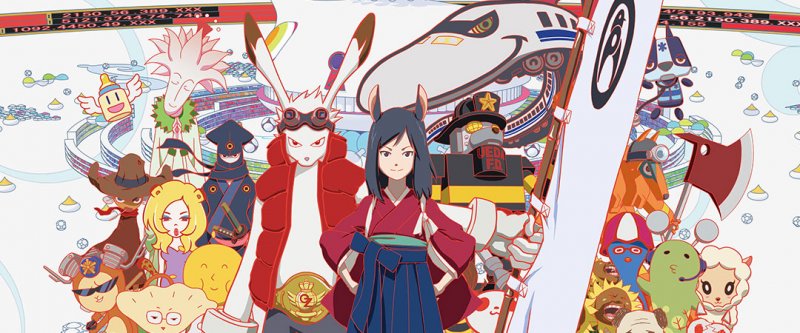Summer Wars: family relations in the science fiction anime
Published:

Summer Wars. (Image source: https://events.umich.edu/event/62774)
Summer Wars is an enjoyable film to watch. Through the depiction of a large traditional Japanese family in a time when virtual reality intertwines with the real world, Mamoru Hosoda discusses the various connections in society as well as in the family in a lighthearted and entertaining way. At first glance, Summer Wars is a science fiction anime that draws creative connections between the virtual world and reality. Indeed, the film illustrates the simple yet resilient family relations through the creative imagination of the relationships between two interrelated worlds and the portrayal of the interactions between family members.
First and foremost, the film spends much effort in illustrating the connections and contrasts between OZ, the virtual reality platform, and the real-world society. It’s worth noticing that people in the real world do not have shadows in this anime. Arguably, most real-world scenes occur indoors, and, naturally, the characters do not have shades there. However, in the scene where Kazuma is practicing Shaolin martial arts in the courtyard, his shadow is deliberately left out compared to the surroundings from the perspective through the window. As the film shifts to a close-up scene, the audience is only presented with the upper half of the character with the shadow still absent. [1:08:00] Through the portrayal of the characters by the absence of shadows and the placement of the two-dimensional characters in the three-dimensional space, the film creates a sense of comics on these characters. The flatness of the real-world characters, then, allows the film to endow the characters with exaggerated yet amusing facial expressions and body movements. For instance, in the scene where Natsuki asks Kenji to pretend to be her boyfriend, the changes in Kenji’s facial expression are exaggerated: first, his mouth becomes widely open as Natsuki gets emotional; he blushes with his whole face running red as Natsuki holds his hands; and finally, Kenji’s face is stretched, and he is stunned by his background information fabricated by Natsuki. [12:59] The dramatized characterizations of the real-world characters impress the viewers and capture their attention, and they also help foster a sense of humor and amusement in the film. In contrast, some characters in OZ are realistic and three-dimensional. For instance, as King Kazma appears at the boxing ring waiting for the challenge against Love Machine, he is delineated as a concrete figure with clear outlines. [1:10:20] The film then presents the viewers with the fight between Love Machine and King Kazma in swift and smooth movements and realistic sound effects. The concrete figures in the virtual reality, if juxtaposed with the flat characters from the real world, then composes an intriguing contrast between OZ and society in reality. While the misplaced characters help balance the homogeneity of the two worlds, the film also cleverly employs them to blur the distinction and boundary between virtual reality and the real world. Furthermore, it implicitly makes it natural for the film to shift between the scenes of OZ and the real-world society and draw various connections between the two parallel worlds.
The connections and contrasts between the virtual and real worlds also demonstrate the differences between the social connections supported by OZ and the emotional connections within the family. The virtual world, or OZ, visualizes complicated but delicate social relationships straightforwardly and objectively. When Love Machine attempts to mess up the OZ infrastructure networks for the first time, the machine data is abstracted to visible entities that are easy to understand. In one iconic scene, Love Machine pushes down a single domino, and the preceding dominos, representing the data related to some infrastructure, are all knocked over in chain reactions. [40:53] Through direct visualization of the failure of the social networks, the film implies that the organizations in the society, as linked together through the seemingly reliable OZ network, are vulnerable to perturbation and can be disorganized easily. On the contrary, the connections within the family, exhibited mainly by the interactions between the Jinnouchi family members, are emotional and implicit. When Natsuki and Kenji sit side by side in the sorrow of the death of Sakae, Natsuki asks Kenji to hold her little finger to stop her tears. [1:00:33] At first, Kenji just holds her little finger. Then he puts his hand on Natsuki’s hand, and finally, they have their fingers crossed. While the film does not convey the message explicitly, we see that Kenji feels empathy with Natsuki, as if Natuski’s sorrow gradually flows into him through their closer and closer physical connections. The whole Jinnouchi family, as exemplified by this detail, is connected by their intimate relationships. Such connections, drastically different from the social connections linked by the OZ networks, prove to be simple but resilient: at the end of the film, we see that OZ, nearly controlled by Love Machine, is restored primarily due to the large “family” composed of people from all over the world that is built simply on the trust in Natsuki and her family members.
The blurry boundaries between virtual reality and the real world and the simple yet resilient connections within the family enable the film to relate the battles against Love Machine in the virtual world to the gradually reunited Jinnouchi family. To begin with, the initial challenge against Love Machine, while relying on several family members’ cooperation, is a trial based on individual capabilities. It is worth noticing that the challenge is portrayed as a fight between Love Machine and King Kazuma individually, while the other family members, as well as other users of OZ, watch the boxing match between Love Machine and King Kazuma as the audience. [1:11:32] Essentially, the isolated efforts of individual characters in the virtual world reflect the weakened connections between the Jinnouchi family members shortly after the death of Sakae: the family is separated to groups when having meals. Men disagree with women on what to do with Sakae’s death. The situation, however, changes as the family gets reunited through their connections. The phone call between Natsuki and Wabisuke, the letter left by Sakae as well as the meal that the family members have together, serve as the medium through which the connections within the family are reinstated and even fortified. Parallelly, the family members exhibit great prowess and solidarity in the ultimate battle against Love Machine in the virtual world. At the climax where Natsuki is playing Hanafuda with Love Machine, the perspective is frequently shifted between the real world and virtual reality. Still, plots and lines are consistent regardless of the transitions. [1:32:25] While the obscured boundary enables the film to shift smoothly between the two parallel worlds, it aids the film in projecting the connections between the family members in reality to the virtual world and therefore allows the audience to perceive the perseverance of the Jinnouchi family in a straightforward yet delightful way.
Noticeably, the film focuses more on the interactions between different family members, which leaves the protagonists, Natsuki and Kenji, not well introduced directly. Shortly after Natsuki introduces Kenji to Sakae, the film shifts to the vivid scenes of different characters in this large family. Afterward, when Natsuki introduces each family member to Kenji at the dinner table, many family members have distinct personalities and even precise occupations but Natsuki’s parents are not present. Interestingly, while the family discusses Natsuki and Kenji at the dinner table, most interactions are presented between the family members themselves. [15:30] On the one hand, the characters Kenji and Natsuki serve to introduce the viewers to the large family, and the film makes it possible for the viewers to directly engage in the Jinnouchi family through the characters Kenji and Natsuki; on the other hand, the film emphasizes the portrayal of the Jinnouchi as a whole rather than the characterization of Natsuki and Kenji. In the scene where Sakae is found dead in her room, every family member is presented surrounding her. [58:09] Likewise, when Love Machine defeats Kazuma, the scene is depicted in a similar structure: Kazuma is in the center of the picture, while every other family member looks at him and listens to him. [1:24:09] Through these scenes, the film underscores that the Jinnouchi family is a whole, and every family member is an integral part of it. Natsuki and Kenji are no different from other family members in this sense. While that explains the reasons why Natsuki and Kenji are not well introduced in the film, the idea of family, manifested by the simple but resilient connections between family members aforementioned, is the core of this film and turns out to be what brings the Jinnouchi to win the Summer Wars.
In conclusion, Summer Wars demonstrates the importance and resilience of family relations through the creative relationship between virtual reality and the real world and the interconnections between family members. While the anime starts with an introduction to the imaginative world of OZ, it ends with a joyful funeral of Sakae, where the Jinnouchi family gather together to celebrate the missed birthday of Sakae. Though technologies can be convenient and dazzling, the film reminds us that we shall not let them overshadow our simple and pleasant family time.

